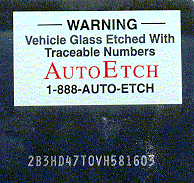Monday, March 30, 2009
- Background
- Statewide Problem Analysis
- Regional Operation Teams
- Statewide Computerized Information System
- Local Agency Assistance/Liaison
- Theft Trends
- Cargo Theft and Organized Crime
- Private Industry/Law Enforcement Training - Awareness
- How to Report a Cargo Theft
- Report Your Theft Online
Background
Over the past decade the cost of cargo theft related crimes has risen dramatically. It is estimated that combined losses suffered by the trucking industry, insurance companies, and the railroads, surpasses $10 BILLION in the United States annually. However, no financial total can adequately quantify the actual costs of cargo theft related losses which includes jobsite downtime, replacement of stolen commercial vehicles, time spent on additional paperwork, and increased insurance costs.
Prior to 1990, in the State of California, no proactive enforcement specifically directed at cargo theft related crimes existed. Consequently, the criminal element determined that the level of profit derived from the theft of cargo loads far surpassed the risk of apprehension. What quickly became apparent to several unethical entrepreneurs was that profits derived from the theft and sale of cargoes were substantial and tax free. Thefts of sought after commodities such as televisions, camcorders, VCRs, and computers, could reach a profit margin as high as .80 cents on the dollar. For example, an organized theft group with several reliable buyers, which stole a load of computers valued at $1 million, conceivably could earn as much as $800,000.00 from the sale of the stolen commodity.
In response to concerns from the California Trucking Association over this rising problem, Assembly Bill 1683 was enacted. This legislation created funding for the enhancement of cargo theft enforcement statewide, and designated the California Highway Patrol (CHP) to coordinate and implement the Program.
Statewide Problem Analysis
It is known, that on a regional level, the incidence of cargo theft is increasing. However, the overall scope of the problem statewide and the specific regions where cargo theft related crime is the greatest have been difficult to accurately determine. This is due to the nature of the commodity that is being stolen, (it is handled by many parties during transportation and distribution) and the inconsistent reporting procedures utilized by both the public and private sectors. To ensure the limited resources that are available for implementation of this Program are utilized in the most efficient way, the CHP gathered detailed information concerning the rate, type and value of cargo being stolen statewide.
In California three regions were identified statistically as suffering the most significant impact from cargo theft related crime. They include Los Angeles / Inland Empire, the San Francisco Bay Area, and San Diego. Each of the identified regions is a major distribution center with major harbors, airports, and rail systems, handling millions of cargo containers and commodities annually. Additionally, within each of the identified regions exists thousands of commercial businesses that ship and receive billions of dollars of merchandise routinely by way of major freeway networks.
With the growing number of cargo thefts statewide, an alliance has been established between law enforcement and private industry to maintain open lines of communication. Organizations such as the Western States Cargo Theft Association, American Trucking Association, California Trucking Association and National Cargo and Security Council. Transportation company security directors and law enforcement personnel, meet on a monthly basis to discuss recent trends, losses, suspects, and active investigations. This type of partnership is the foundation of successful cargo theft enforcement.
Regional Operation Teams
In a state as large and diverse as California, each geographic region is unique as to the extent and type of problem being experienced. In some areas, efforts are already ongoing to address the cargo theft problem. In others, virtually nothing is being done in any coordinated manner. Because of these factors, the approach that will be taken in each region may be different; however, efforts will be made to establish regional teams that can serve as a proactive response to this type of crime.
Statewide Computerized Information System
The timely exchange of information between private industry and the numerous law enforcement agencies statewide is crucial to effectively combat the cargo theft problem. As such, development of a uniform statewide system that will link the regional operations has been completed. This will greatly enhance investigative efforts and provide detailed statistical information concerning the scope of the cargo theft problem, as well as provide trend analysis.
Local Agency Assistance/Liaison
One component of the Cargo Theft Interdiction Program is to support the efforts of local law enforcement agencies and improve the level of liaison among the various groups that are combating cargo theft related crime. CHP CTIP investigators work with local law enforcement agencies in an effort to recover stolen cargoes and follow-up on intelligence leads to combat cargo theft.
Theft Trends
Armed Robberies
In Southern California, cargo thefts by way of armed hijackings and/or terminal robberies have increased during the last five years. Common trends involving cargo theft armed robberies include the following:
- Terminal Robberies - organized theft groups enter a trucking facility, hold the security guard(s) and or employees hostage, and proceed to steal one or several loaded vehicles.
- Hijackings - generally occur when a truck driver comes to a stop, be it at a signal light, truck stop, or dinner break. Theft groups will actually surveil the targeted commercial rig after receiving inside information regarding the transported load. Once the driver stops his rig, one or several gunman will enter the cab, detain the driver, and transport the load to a pre-determined destination. Eventually the driver is set free some distance from the theft location. Note: a percentage of hijackings are staged and involve the drivers.
- Hijackings (coerced stops) - one common method used to coerce a driver to make an unplanned stop is the use of a female, sometimes scantily dressed, who gains the driver's attention while in transport. Typically, the female accomplice will falsely inform the unsuspecting driver that something is mechanically wrong with the rig. Consequently, the driver will pull to the side of the roadway for the purpose of inspecting his vehicle. Once the rig is stopped, armed suspects, traveling in an additional vehicle, will approach the driver and steal the rig.
Burglaries
Burglaries often occur at transportation truck yards, commercial parks, and railroad yards. Commonly, theft groups will enter the targeted facility, post look-outs, and spend several hours opening trailers and containers searching for a desirable commodity to steal. These crimes most often occur during the hours of darkness and or during the weekend. Common burglary tools include bolt cutters, tin snips, pliers, screwdrivers, flashlights, and filed down ignition keys.
Additional Trends
- Driver Giveaways - where a driver actually participates in the conspiracy to steal a loaded rig. Drivers generally agree to turn over their rig to a theft group for a substantial cash payment.
- Employee Involvement - occurs when a company employee, who has advanced knowledge of a specific trailer or container's load, provides cargo and transportation information to a theft group in preparation for theft.
- Counterfeit Paperwork - generally used by independent drivers who transport chassis/containers from container terminals. Drivers present counterfeit paperwork to the security guards and ultimately make off with valuable loads.
- Grab and Runs - often used by theft groups targeting trucks loaded with high-tech equipment. Crooks, traveling in family type vans, follow a targeted truck and once the rig stops, several suspects exit the van, open the trailer doors, and off-load as much property as they can before the rig proceeds.
- Warehousing Stolen Cargoes - often times stolen rigs are transported to a pre-designated storage facility for off-loading and storage of stolen commodities. Warehouses include, but are not limited to, industrial storage facilities, public storage facilities, restaurants, pallet yards, single-family houses, apartments, and condemned buildings.
Cargo Theft / Organized Crime
Cargo theft is, in essence, a form of organized crime. Granted, in California cargo theft is not generally committed by proverbial mafia families, however, it is organized crime and in many cases violates Federal Statutes. The following is a list of applicable Federal Law that directly relates to Cargo Theft and Racketeering:
- Title 18 U.S. Code, Section 659: Theft from interstate shipments, UPS, Federal Express, Airborne Express, Etc.
- Title 18 U.S. Code, Section 1951: Interference with commerce by threat or violence.
- Title 18 U.S. Code, Section 1952: Interstate and foreign travel or transportation in aid of racketeering.
- Title 18 U.S. Code, Section 1957: Engaging in monetary transactions in property derived from specified unlawful activity (Cash value greater than $10,000).
- Chapter 96: Racketeer Influenced and Corrupt Organizations
- Title 18 U.S. Code, Section 1961 (1): definition of racketeering activity, to include any act or threat involving murder, kidnapping, gambling, arson, robbery, etc.
- Title 18 U.S. Code, Section 2117: The breaking and entering of a carrier facility, as well as breaking the seals of railcars, commercial trailers.
- Title 18 U.S. Code, Section 2314: Interstate transportation of stolen property of a value of $5,000 or more.
- Federal car-jacking statutes.
Private Industry/Law Enforcement Training - Awareness
Extensive effort will be directed toward improved liaison and increased training/awareness among law enforcement and the private sector. Through these joint efforts of state agencies, local law enforcement and private industry, enhancements will be made in the reporting procedures currently being followed when cargo thefts occur. This will include the issues of timely notification by victims, documentation by law enforcement and the automated tracking of this information on a statewide level. The CHP encourages the continued support of private industry by providing investigative information. Attached are the CTIP Loss Reports for most of the regional teams. Please duplicate the forms and use them to notify the respective regional team of any losses as soon as possible.
Implementation of the CTIP is seen as a significant opportunity to positively impact the serious problem of cargo theft related crime within California. Success of the Program is dependent upon an alliance between law enforcement and private industry. Any input or assistance that you can provide toward the implementation of the CTIP would be greatly appreciated.
Labels: Cargo Theft
posted by transport blogs
@ 10:39 PM
permanent link | Post a Comment |
0
comments
![]()
Wednesday, March 25, 2009
The system allows state motor vehicle administrators to verify and exchange titling and brand data and provides law enforcement officials, consumers, and others with critical information regarding vehicle histories. Consumers now have access to the vehicle's brand history, odometer data, and basic vehicle information and can be redirected to the current state of record to access the full title record if available. Law enforcement can track the vehicle's status from state to state by accessing the system directly.
According to the National Insurance Crime Bureau, car theft is a profitable business generating nearly $8 billion a year. Along with implementing this system, the Department has outlined the various responsibilities and reporting requirements for states, auto recyclers, junk yards and salvage yards, and insurance carriers. The Department has designed the system consistent with federal law that requires that the system be paid for through user fees and not dependent on federal funding.
Since 1997, the Department of Justice has committed over $15 million to assist states and other stakeholders in the implementation of NMVTIS. Currently, NMVTIS has the participation, or partial participation, of 36 states. Ultimately, with full participation from all 50 states and the District of Columbia, NMVTIS will prevent stolen motor vehicles, including clones, from entering into interstate commerce; protect states and consumers from fraud; reduce the use of stolen vehicles for illicit purposes including fundraising for criminal enterprises; and provide consumer protection from unsafe vehicles. In research conducted by the Logistics Management Institute, the system is estimated to save taxpayers between $4 and $11 billion each year. For further information on NMVTIS, visit www.nmvtis.gov.
The Office of Justice Programs, headed by Acting Assistant Attorney General Laurie Robinson, provides federal leadership in developing the nation's capacity to prevent and control crime, administer justice, and assist victims. OJP has five component bureaus: the Bureau of Justice Assistance; the Bureau of Justice Statistics; the National Institute of Justice; the Office of Juvenile Justice and Delinquency Prevention; and the Office for Victims of Crime. Additionally, OJP has two program offices: the Community Capacity Development Office, which incorporates the Weed and Seed strategy, and the Office of Sex Offender Sentencing, Monitoring, Apprehending, Registering, and Tracking (SMART). More information can be found at http://www.ojp.gov.
posted by transport blogs
@ 10:56 PM
permanent link | Post a Comment |
1
comments
![]()









